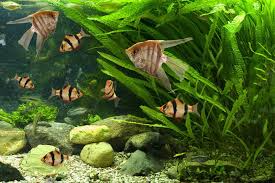A fish aquarium filtration system is one of the most crucial components in maintaining a healthy and thriving aquatic environment. Whether you are a beginner or an experienced aquarium enthusiast, understanding how the filtration system works can significantly impact the well-being of your fish and the overall aesthetics of your aquarium. In this article, we will explore the different types of filtration systems, their importance, and tips for choosing the right one for your aquarium.
Why is a Fish Aquarium Filtration System Necessary?
In a natural aquatic environment, the water is constantly filtered through processes like evaporation, rain, and the natural decay of organic matter. In a confined space like a fish aquarium, the water doesn’t have the same ability to self-purify. As a result, waste from fish, uneaten food, and decaying plants can build up, causing harmful toxins like ammonia, nitrites, and nitrates to accumulate. These substances can quickly become lethal to your fish if not properly removed.
A fish aquarium filtration system plays a critical role in maintaining water quality by removing debris, toxins, and harmful bacteria, ensuring that the water remains clear, oxygenated, and free of harmful pollutants. Without a filtration system, the health of your fish will suffer, and the aesthetic appeal of your aquarium will diminish due to cloudy, dirty water.
Types of Fish Aquarium Filtration Systems
There are three primary types of filtration systems used in fish aquariums: mechanical, biological, and chemical filtration. Each type serves a different function, but together, they work in harmony to keep the water clean and safe for your fish.
1. Mechanical Filtration
Mechanical filtration is the most basic type of filtration and involves the physical removal of debris from the water. This is typically achieved through a filter sponge, foam, or mesh material that traps particles like uneaten food, fish waste, and detritus. The water passes through the filter media, and the debris is captured, leaving the water cleaner and clearer.
Mechanical filters are essential for keeping the water visually appealing by preventing cloudiness. They should be cleaned or replaced regularly to prevent clogging and ensure they continue functioning effectively. Some filtration systems, such as hang-on-back (HOB) filters, use mechanical filtration as part of a multi-stage process.
2. Biological Filtration
Biological filtration relies on beneficial bacteria to break down harmful substances in the water, particularly ammonia and nitrites. Ammonia is a toxic compound produced by fish waste, decaying organic material, and uneaten food. In the presence of oxygen, beneficial bacteria like Nitrosomonas and Nitrobacter convert ammonia into nitrites, and then into nitrates, which are less harmful to fish in small quantities.
Biological filtration is achieved through media like bio-balls, ceramic rings, or porous rock that provide a surface area for the bacteria to colonize. This process is essential for maintaining long-term water quality in your fish aquarium and preventing dangerous spikes in ammonia or nitrite levels. It is a natural and sustainable way to keep the aquarium environment safe.
3. Chemical Filtration
Chemical filtration uses materials like activated carbon or resins to remove dissolved impurities, toxins, and chemicals from the water. These substances include medications, heavy metals, chlorine, and unwanted odors. Activated carbon is one of the most commonly used media for chemical filtration due to its ability to adsorb a wide range of pollutants.
While chemical filtration is not essential for day-to-day water maintenance, it can be particularly useful when dealing with specific problems, such as removing medications after treatment or clearing up cloudy water caused by dissolved organic compounds. It is important to replace chemical filter media regularly to maintain its effectiveness.
Choosing the Right Fish Aquarium Filtration System
Selecting the appropriate fish aquarium filtration system depends on several factors, including the size of your aquarium, the type of fish you have, and the specific needs of your aquatic environment. Here are some tips to help you make an informed decision:
1. Aquarium Size and Type of Fish
The size of your aquarium plays a significant role in determining the filtration system you need. A larger aquarium will require a more powerful filtration system to maintain water quality. Additionally, if you have a heavily stocked aquarium with many fish, a stronger filtration system will be necessary to handle the increased waste load.
Different types of fish also have varying requirements for water quality. For instance, tropical fish may require more delicate filtration to avoid strong currents, while saltwater fish often need more advanced filtration systems due to the higher salinity and complexity of their environment.
2. Types of Filters
When choosing a fish aquarium filtration system, consider the different types of filters available:
- Hang-on-back (HOB) filters: These are external filters that hang on the back of the aquarium and are easy to install and maintain. They are ideal for smaller to medium-sized tanks.
- Canister filters: These provide powerful filtration for larger aquariums and are located outside the tank, offering mechanical, biological, and chemical filtration in one unit.
- Sump filters: A sump is an additional tank placed below the aquarium that houses the filtration equipment. It is commonly used in large aquariums, especially saltwater setups.
- Internal filters: These filters are submerged inside the aquarium and are ideal for smaller tanks or aquariums with limited space.
3. Maintenance Requirements
Regular maintenance is essential for the optimal performance of your fish aquarium filtration system. Check the manufacturer’s instructions for cleaning and replacing the filter media, and ensure the pump is functioning efficiently. Neglecting regular maintenance can lead to reduced filtration efficiency and poor water quality.
Conclusion
A well-maintained fish aquarium filtration system is essential for keeping your aquarium water clean, clear, and safe for your fish. By understanding the different types of filtration, how they work together, and how to choose the right system for your needs, you can ensure a healthy, thriving aquatic environment. Whether you’re just starting with your first aquarium or looking to upgrade your filtration system, investing in the right equipment will make a world of difference for both the health of your fish and the beauty of your aquarium.



